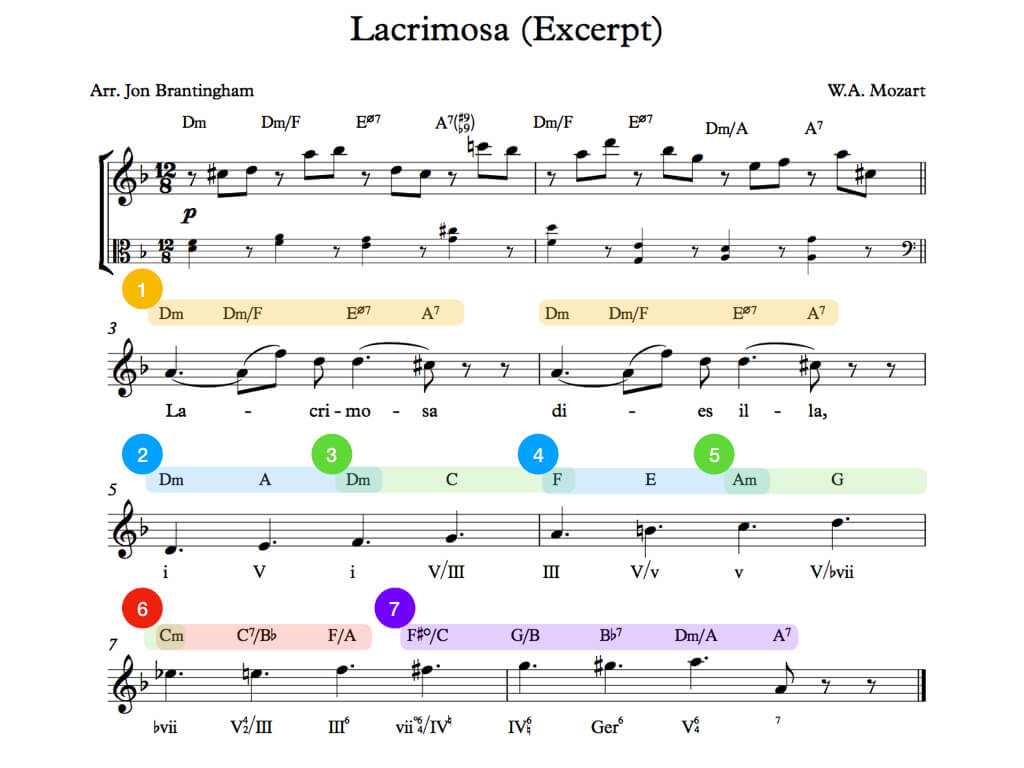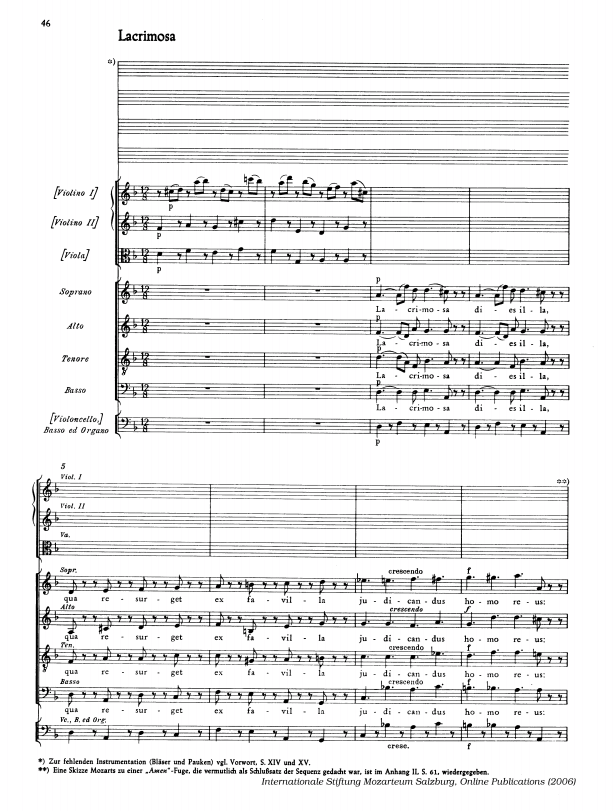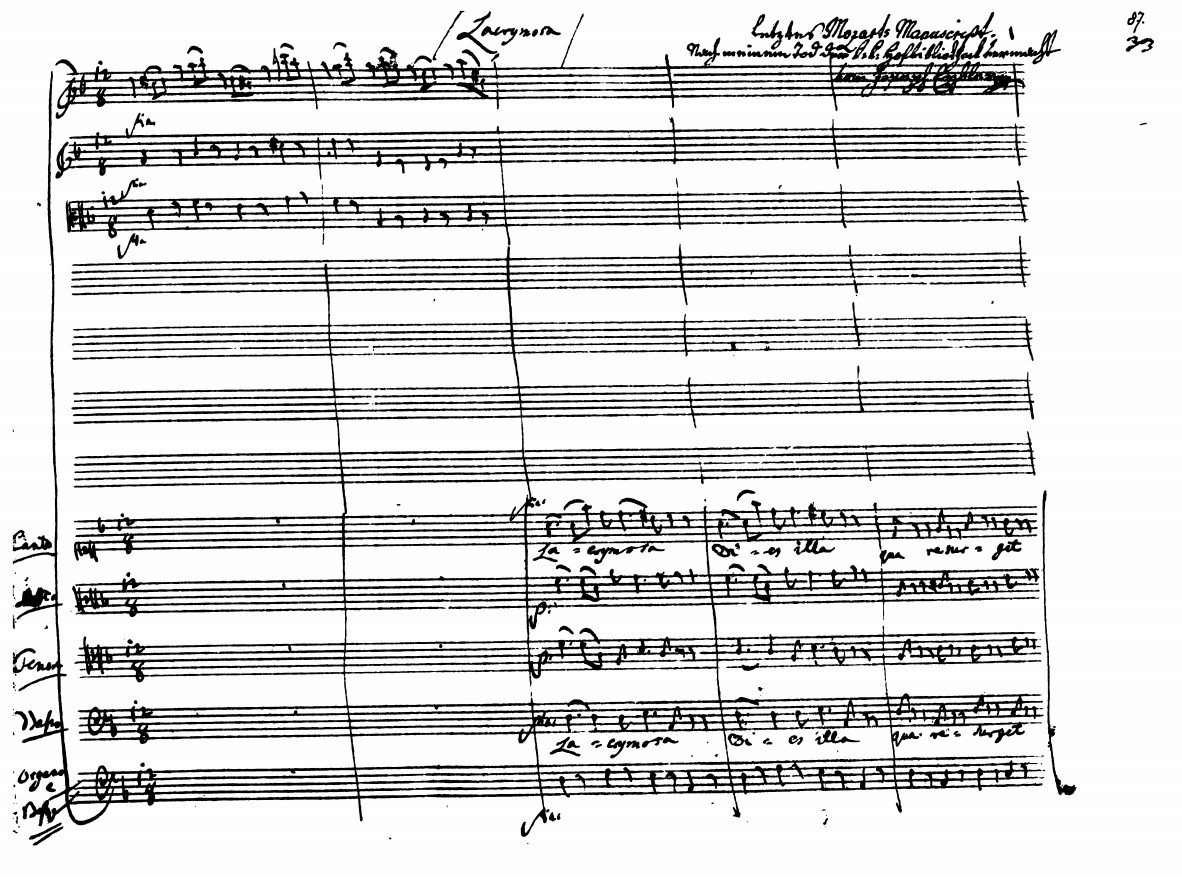Why Learn the Melody and Chord Progression?
One of the best ways to master composition is to memorize the musical meaning of a passage, and be able to use it in a different way.
Memorization, abstraction, and reuse are at the heart of traditional composition teaching methods, known as partimenti.
A similar and more modern way to get the same benefit, is to create leadsheets from pieces that you like. You can make it as simple or difficult as you’d like, which allows you to play it with minimal piano skills. In the process you figure out the harmony, create a tool for easy internalization and transposition, and can use it to memorize the piece.
The best part is, you don’t have to do entire pieces. You can just pick a short segment that speaks to you.
So let’s look at Mozart’s Requiem for a minute to understand the process.
My Process for Internalizing a Chord Progression
Step 1: Listen
It all starts with hearing a passage that strikes you as particularly powerful. A great example is the opening from Mozart’s Lacrimosa.
To internalize something, you need to know what it sounds like. So let’s listen to the real thing first. It is only an excerpt, so it will go quick. Only listen up to about 22:02.
This short progression is great because it covers a bunch of harmonic motions that you can use immediately.
Step 2: Simplify as a Lead Sheet
I am a self-taught pianist, which means it takes me a while to master music on the piano. To memorize more music, I like to simplify the original.
This effectively means taking a score, and then turning it into a lead sheet. Most of the time I don’t write it out, usually just simplifying from the original score directly. But the goal is the same.
Lead sheets are great learning tools. You are forced to figure out the harmony as a chord symbol, and abstract the core of the melody. Unlike roman numeral analysis, chords are more flexible, avoiding any specific functional interpretation, as long as you have the right notes. (I also did roman numeral analysis starting at measure 5, but that isn’t vital).

Step 3: Memorize in the Original Key
This part is not complicated, but it takes time. You need to be able to play the excerpt in the original key with the melody.
It’s really about repetition and analyzing, so let’s dive in.
Learn to play the opening as is, because it’s relatively straight forward. This is a great chance to practice reading alto clef, as the original is for Violins and Violas.

Step 4: Practice Transposing at the Piano
To transpose, I find it helps to identify the smaller harmonic chunks within the progression. If you notice on my lead sheet, the chunks are contained in their own bubbles.
- i-i 6-ii-V-(i). The opening is very typical, two measure complete cadential progression. Not only would it work as a cadence, but it can be great for opening ideas, as it clearly defines the tonality.
- i-V-i. This is the fundamental harmonic movement of classical music, and should be automatic in all keys, major and minor, in all inversions.
- Down a whole step to a V-i in major (F). Notice 3, 4, and 5 are all very similar, but they are going to different tonal areas.
- Down a half step to a V-I in minor (Am).
- Down whole step to a V-i in minor (Cm).
- ♭vii – V 4/2 of IV – IV 6 (F).
- Up a minor 3rd to a diminished chord (Cº) which begins the progression viiº 6/4 – IV – Ger 6 – V 6/4 – V 5/3. This final progression moves downward by half-step to a dominant 7th chord. This is also known as a German 6th (Bb7). The German 6th usually leads to a cadential ⁶/₄ which is a i chord with the 5th in the bass, putting it in 2nd inversion. This ends with a half-cadence.
By breaking up the progression into smaller chunks, you can transpose one part, and then work from there.
Step 5: Use It
The best way to start using something like this, is to start by improvising with it. This allows you to experiment with it, trying out ideas, before committing them to paper.
Locking It In
Once you play through the progression enough times, you should have it locked in. This is especially true when you start to transpose and improvise over it.
Just like learning jazz tunes in all 12 keys, this is a critical component of learning to compose.

Thank you for your analysis! I spent about an hour picking this apart by ear on guitar before searching for what sense somebody made of it and was very happy to find that I just had some weird inversions and nothing missing. It’s great to read what you made of the foray away from the key center and I appreciate it!
It’s sorry but Too many cases have been found to reveal misleading analysis. My profession was a professor of composition majoring at the University of Music in S. Korea, and I have analyzed thousands of compositions in my life.
Unfortunate but your analysis is wrong.
Analyziing harmonic progression is the process of logically defining center of the key and tonal.
In the phrase where the continuously chromatic rise, it is clear that there is a change to closely related key and this phenomenon involves the process of returning to the original key center. On the ascending phrase, the tune leaves Dm, returns through C and Cm and back to origin Dm. The key Dm and C have only one flat pattern change, and C and Cm have a parallel relationship. This change is one of the common devices to broaden the tonal.
Analysis of the process of changing the key requires a double analysis using parentheses. And Analysis is a Logical representation of the universal center that the listener feels.
Hi Jeonghoon,
Thanks for the close reading of my article. I’ll take into consideration your analysis if I ever need to update this page.
I don’t really agree that analysis is the process of logically defining the center of the key and tonality. To me, analysis is the process of systematically understanding a piece. You can analyze a piece on many different dimensions. While key center and tonality are one, you could analyze the rhythmic aspects, the orchestration, or even the historical context of the piece, all without needing to know the key center.
As far as my own harmonic analysis, there is a somewhat baked in idea, that if you have a V-I, it implies a change of key area, simply because you are also playing cadences. This is just a temporary modulation and since no key signature changes are made, I didn’t actually feel the need to clutter things up with parentheses.
My ultimate goal is to make each segment of the progression something that you can practice as a single unit, to see that simpler blocks can make a large progression. This first part of this progression is a well known sequence called an ascending 3rd. Often, with the ascending 3rd sequence, you place applied dominants between the chords, to give it a smoother or more dramatic sound. The ascending 3rds are Dm-F-Am-C.
Now from the C minor, you could analyze it as a change in key, which is fine. But you lose context of what certain critical chords mean within the key.
For instance, you can look at the ♭vii as a C minor root, but then the following chord C7/B♭ is not a part of the C minor scale, nor is it part of the C major. But F/A is a part of D minor. If you label them in relation to the root, you can see how chromatic alterations can get you seemingly very far from the key center without too much thought about modulating and what that means.
Personally, this approach has lead to a more intuitive sense of harmony, and practical ways to actually modulate when I improvise. For instance, now I know that in D minor, I can play an ascending 3rd sequence, I can use ii-V’s on just about any chord in the key. I know that the ♭vii minor chord is C minor, and that I can do a quick imperfect cadence back to III from there. I learned a really cool chromatic cadence at the end, and none of it relies on full modulation and relabeling the key center.
But the ability to analyze it in different ways is useful, and so I applaud you.
Although I see where you are going, I must agree with JEONGHOON RHEE. The tonal music is written in a specific form, and you can change whatever you want in your perspective, but that does not make your analysis correct. Also, for people who want to understand this music better and profoundly, you are making a mess! I have seen 9th chords in your analysis that are so wrong, even in a practical point of view; not only they are not 9th chords, but everyone knows that Mozart do not use these chords and that is one characteristic of his music. And this is only a small example.
I am sorry, but teaching people to put the fingers in a certain way is not helping them to play music. It is like when we are children and in the school they make us learn a poem that we do not understand: we repeat the words but we have no clue about what we are saying. Even the intonation will be wrong.
So basically you are teaching people to be ignorants, and all those who after being amateurs decide to study music properly, will have to unlearn and learn all these things again in a proper and logical way. It is a waste of time!
Also, you can disagree all what you want with professionals, but receiving a musical training takes many years, and even those musicians who are professionals but did not study in music centers also have to learn and practise for many years before they play and understand the music well. Amongst all those perspectives, this one that you write here is not even admissible, and I know that because I am a professional pianist, harpsichordist, organist, pedagogue and one of my specialties is contemporary music and jazz. I have learned harmony in all the possible ways, and yours does not make sense whatsoever, not even in the most practical perspective as I said.
Please, do not teach people wrong; they will end thinking that music is a joke and playing an instrument is moving fingers. There are so many good methods to teach people how to play certain songs and pieces without making them think that music is a sort of caricature!
You know I debated whether I should ignore this message or just delete, but I decided to leave it.
I want to leave it to show the world two perspectives. I am a seeker, I make mistakes, I fully acknowledge that. But what I don’t do, is tear people down with my credentials.
Music analysis is about understanding music, and I find other explanations lacking. I hesitate to say wrong, because wrong is the most destructive word in music. I hear it all the time from people who call themselves things like “professional pianist, harpsichordist, organist, pedagogue”.
Wrong is what you get told by “professionals” who are certain that their view on music is the only one. Wrong is what college trained professors say when you do something they don’t like. Wrong is telling a teenager to be creative, explore their possibilities and then make them change their results to fit some preconceived notion of what better music is.
Now as far as the 9th chord goes, you can view it and hear however you want. To my “untrained” ears, I hear that 4th chord in measure 1 as a V chord. It clearly has the same feel as the progression in measure 3. And so I labeled it a V7 chord. This makes sense.
The C natural and Bb in the melody create dissonance specifically with the C#, and in the context of jazz chord notation, they make sense as a #9 moving to a b9. To be fair, Mozart notated it as flat 3rd, which is enharmonically equivalent to a #9. The problem is that if you write a flat 3rd would be very misleading harmonically.
I also believe the bass note is implied at that moment. I’ve labeled it using standard jazz chord notation, which in my own experience, is much easier for others to understand.
With this kind of analysis, it basically becomes a i-i6-iiø-V7-i. But that would make too much sense, let’s cloud it up.
Now the way that you say “The tonal music is written in a specific form” really shows me your own lack of understanding of musical form. Show me “the form” of tonal music. Anything you show me as an exemplar, I will show you something else that does something very different. That is because the form is emergent from the piece and not the other way around.
Now as far as the key center goes, it’s in D minor, it stays in D minor, and Mozart cadences ends with a half-cadence on V7. You could try to say that Mozart is modulating to C minor, ♮7 in relationship to the key, but then you would be forced to change key centers once again immediately following that as the C7 is not in that key, neither is F. But F is in D minor.
Clearly a statement like this speaks for itself. There is obviously nothing more for you to learn, oh wise one.
I am sure you also tell people all the time to go to college, get themselves into crazy debt, and then what? I’ve seen many of my musician friends, all actual professionals with skills that people pay to listen to, suffer because the system that trains them destroys their life through debt. It’s bullshit.
I offer my experience, and perspective for free. No one has to read it. And then I ask for a very small amount to help get people started on the right track. I am not their teacher, I am not here to coddle them and hold their hand. I am here simply to explore music with them.
Just a quick note to say that your “lead sheet” analysis is a helpful tool for me. I’m a choir director who is trained in common practice period analysis and figured bass notation, but I’m also a practicing musician and a lead sheet with “jazz” symbols feels more like a native language to me. From there, I can easily do my own functional analysis on the fly. But for internalizing, memorizing, and replicating basic harmonic patterns, this is how my brain will best process it. I understand that if someone is just learning harmonic analysis this could confuse them, but there are so many tools out there for them. For those of us less concerned with style guides and more concerned with practical application, this kind of quick and dirty analysis/cheat sheet fills a need.
Of course I understand Mozart wasn’t thinking in terms of jazz extensions. But I know what it means, and once I have it under my fingers and I can think through what he might have been trying to accompliah. Thanks.
Thanks Tyler!
This was so incredibly helpful and easy to understand. It has always been a bit of a struggle but I am finally getting confident with it. Thank you so much.
The roman numerals are not clear to me. Referring the excerpt, Why do you use a flat for bvii (Cm) and not for III (F)? Isn’t C the vii in Dm natural? I’d expected just vii for Cm.
tanks for your teach
im a girl who studies composing in iran and as you know there’s less instruction here. people like you are so kind to offer these things in internet.🙏
Awesome. I love spreading music around the world.
This is awesome! I’m a film composer from Melbourne and it’s great to find new ways to challenge myself. Thanks so much for this 🙂